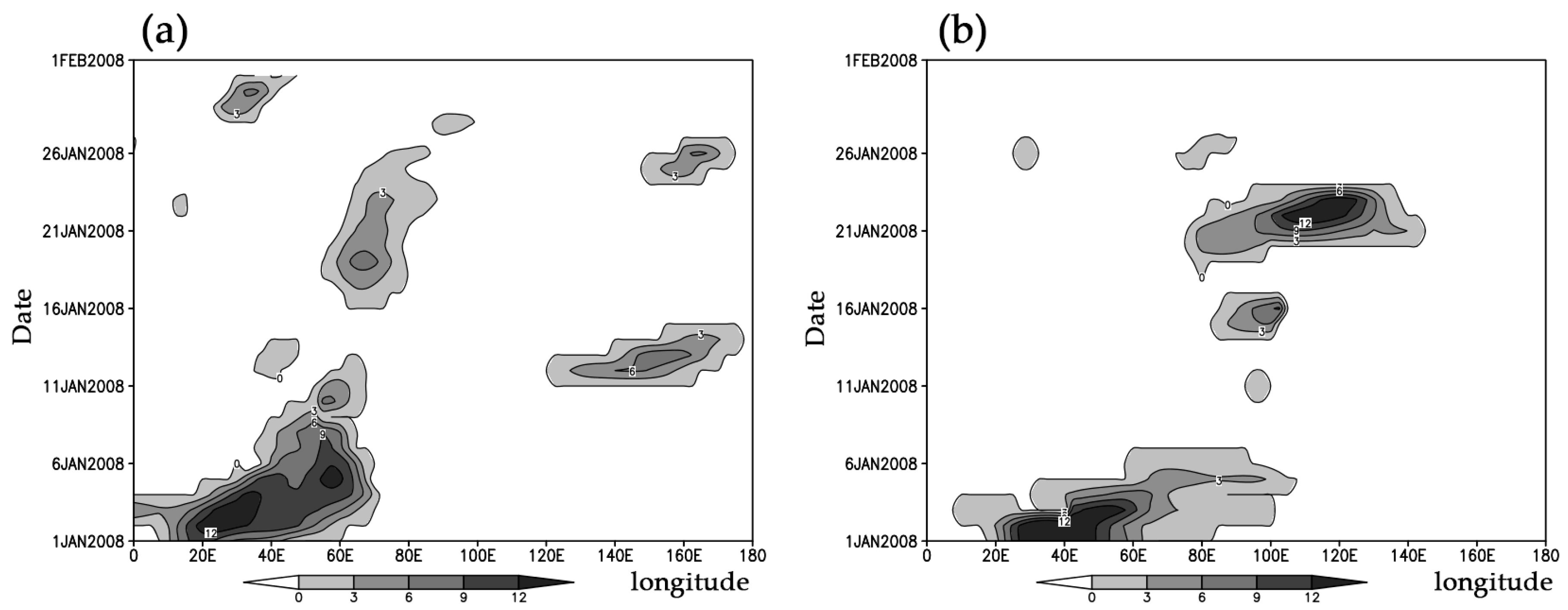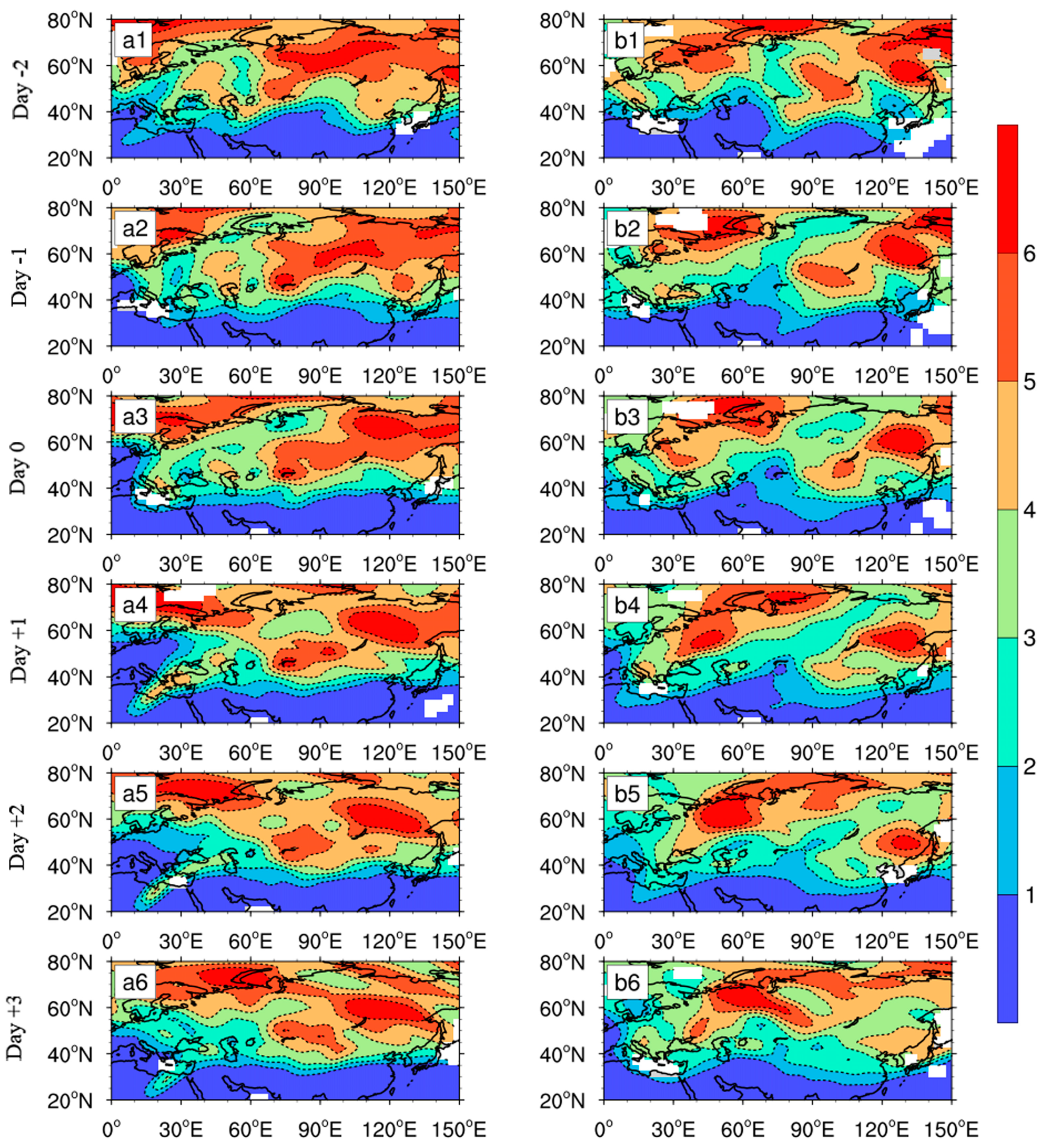Characteristics of Transient Eddy Fluxes during Blocking Highs Associated with Two Cold Events in China
Abstract
1. Introduction
2. Data and Methodologies
2.1. Data
2.2. Methodologies
2.2.1. Recognition of a Blocking Event
- (1)
- GHGS > 0,
- (2)
- GHGN < −10 m· degree−1.
2.2.2. Momentum and Heat Transport of Transient Eddies
2.2.3. The Generalized E-P Flux
2.2.4. The Ertel’s Potential Vorticity (PV)
2.2.5. Two Cases of Cold Events
3. Characteristics of Transient Eddy Momentum Transport
4. Characteristics of Transient Eddy Heat Transport
5. Related Characteristics of E-P Flux and RWB
6. Conclusions and Discussion
Author Contributions
Funding
Conflicts of Interest
References
- Chen, T.C.; Yen, M.C.; Huang, W.R.; Gallus, W.A. An East Asian cold surge: Case study. Mon. Wea. Rev. 2002, 130, 2271–2290. [Google Scholar] [CrossRef]
- Cui, L.; Shi, J.; Du, H.; Wen, K. Characteristics and trends of climatic extremes in China during 1959–2014. J. Trop. Meteorol. 2017, 22, 368–379. [Google Scholar]
- Seneviratne, S.I.; Nicholls, N.; Easterling, D.; Goodess, C.M.; Kanae, S.; Kossin, J.; Luo, Y.; Marengo, J.; Mcinnes, K.; Rahimi, M. Changes in climate extremes and their impacts on the natural physical environment: An overview of the IPCC SREX report. In Proceedings of the Egu General Assembly Conference, Vienna, Austria, 22–27 April 2012; p. 12566. [Google Scholar]
- Tao, S.Y.; Wei, J. Severe snow and freezing rain in January 2008 in Southern China. Clim. Environ. Res. 2008, 13, 337–350. [Google Scholar]
- Yao, Y.; Luo, D.; Dai, A.; Simmonds, I. Increased quasi stationarity and persistence of winter Ural blocking and Eurasian extreme cold events in response to Arctic warming. Part I: Insights from observational analyses. J. Clim. 2017, 30, 3549–3568. [Google Scholar] [CrossRef]
- Rex, D.F. Blocking action in the middle troposphere and its effects upon regional climate. I: An aerological study of blocking action. Tellus 1950, 2, 196–211. [Google Scholar] [CrossRef]
- Takaya, K.; Nakamura, H. Mechanisms of intraseasonal amplification of the cold Siberian high. J. Atmos. Sci. 2005, 62, 4423–4440. [Google Scholar] [CrossRef]
- Lau, N.C.; Lau, K.M. The structure and energetics of mid-latitude disturbances accompanying cold-air outbreaks over East Asia. Mon. Wea. Rev. 1984, 112, 1309–1327. [Google Scholar] [CrossRef]
- Yeh, T.C. On energy dispersion in the atmosphere. J. Atmos. Sci. 2010, 6, 1–16. [Google Scholar] [CrossRef]
- Rossby, C.G. On the dynamics of certain types of blocking waves. Chin. J. Geophys-Ch. 1951, 2, 1–13. [Google Scholar]
- Charney, J.G.; DeVore, J.G. Multiple flow equilibria in the atmosphere and blocking. J. Atmos. Sci. 1979, 36, 1205–1216. [Google Scholar] [CrossRef]
- Luo, D. Interaction between envelope soliton vortex pair blocks and synoptic-scale eddies in an inhomogeneous baroclinicity environment. Q. J. Roy. Meteor. Soc. 2010, 131, 125–154. [Google Scholar] [CrossRef]
- Li, S. Impact of Northwest Atlantic SST anomalies on the circulation over the Ural Mountains during early winter. J. Meteorol. Soc. Jpn. 2004, 82, 971–988. [Google Scholar] [CrossRef]
- Luo, D.; Xiao, Y.; Diao, Y.; Dai, A.; Franzke, C.L.E.; Simmonds, I. Impact of Ural blocking on winter warm arctic-cold Eurasian Anomalies. Part II: The link to the North Atlantic Oscillation. J. Clim. 2016, 29, 3949–3971. [Google Scholar] [CrossRef]
- Nath, D.; Chen, W. Impact of planetary wave reflection on tropospheric blocking over the Urals–Siberia region in January 2008. Adv. Atmos. Sci. 2016, 33, 309–318. [Google Scholar] [CrossRef][Green Version]
- Zhu, W.J.; Sun, Z.B. Effects of eddy ageostrophic geopotentiaI fluxes on the maintenance of storm tracks. Chinese. J. Atmos. Sci. 2001, 25, 71–78. [Google Scholar]
- Nakamura, H.; Wallace, J.M. Observed changes in baroclinic wave activity during the life cycles of low-frequency circulation anomalies. J. Atmos. Sci. 1990, 47, 1100–1116. [Google Scholar] [CrossRef]
- Chen, W.Y. Effects of transient eddies on blocking flows: General circulation model experiments. Mon. Wea. Rev. 2009, 120, 787–801. [Google Scholar] [CrossRef]
- Athar, H.; Lupo, A.R. Scale analysis of blocking events from 2002 to 2004: A case study of an unusually persistent blocking event leading to a heat wave in the gulf of Alaska during August 2004. Adv. Meteorol. 2010, 12, 185–194. [Google Scholar] [CrossRef]
- Xu, H.; Jin, R.H. Analysis on the effect of the transient eddy on Ural blocking high in 2008. Plateau. Meteor. 2011, 45, 286–298. [Google Scholar]
- Yun, K.S.; Seo, Y.W.; Ha, K.J.; Lee, J.Y.; Kitoh, A. The seasonally varying effect of the Tibetan Plateau on Northern Hemispheric blocking frequency and amplitude. Clim. Dynam. 2016, 47, 2527–2541. [Google Scholar] [CrossRef]
- Xie, Z.W.; Bueh, C. Blocking features for two types of cold events in East Asia. J. Meteor. Res. 2017, 31, 309–320. [Google Scholar] [CrossRef]
- Bueh, C.; Ning, S.; Xie, Z. Large-scale circulation anomalies associated with persistent low temperature over Southern China in January 2008. Atmos. Sci. Lett. 2011, 12, 273–280. [Google Scholar] [CrossRef]
- Qian, C.; Wang, J.; Dong, S.; Burke, C.; Ciavarella, A.; Dong, B.; Freychet, N.; Lott, F.C.; Tett, S.F.B. Human influence on the record-breaking cold event in January of 2016 in Eastern China. B. Am. Meteorol. Soc. 2017, 99, S118–S122. [Google Scholar] [CrossRef]
- Kalnay, E.; Kanamitsu, M.; Kistler, R.; Collins, W.; Deaven, D.; Gandin, L.; Iredell, M.; Saha, S.; White, G.; Woollen, J.; Zhu, Y.; Leetmaa, A.; Reynolds, R.; Joseph, J.D. The NCEP/NCAR 40-year reanalysis project. B. Am. Meteorol. Soc. 1996, 77, 437–472. [Google Scholar] [CrossRef]
- Tibaldi, S.; Molteni, F. On the operational predictability of blocking. Tellus. A 1990, 42, 23. [Google Scholar] [CrossRef]
- Pelly, J.L.; Hoskins, B.J. A new perspective on blocking. J. Atmos. Sci. 2003, 60, 743–755. [Google Scholar] [CrossRef]
- Austin, J.F. The blocking of middle latitude westerly winds by planetary waves. Quart. J. R. Meteor. Soc. 1980, 106, 327–350. [Google Scholar] [CrossRef]
- Holton, J. Introduction to Dynamic Meteorology, 4th ed.; Academic Press: Cambridge, MA, USA, 1979. [Google Scholar] [CrossRef]
- Andrews, D.G.; Mcintyre, M.F. Planetary waves in horizontal and vertical shear: asymptotic theory for equatorial waves in weak shear. J. Atmos. Sci. 1976, 33, 2049–2053. [Google Scholar] [CrossRef]
- Teubler, F.; Riemer, M. Dynamics of Rossby wave packets in a quantitative potential vorticity potential temperature framework. J. Atmos. Sci. 2016, 73, 1063–1081. [Google Scholar] [CrossRef]
- Hitchman, M.H.; Huesmann, A.S. A seasonal climatology of Rossby wave breaking in the 320–2000-K layer. J. Atmos. Sci. 2007, 64, 1922–1940. [Google Scholar] [CrossRef]
- Nie, Y.; Sun, L.; Wang, D.M.; Li, D. Possible causes for the sudden drop of air temperature in the Northern Hemisphere from early-to mid-winter. Meteor. Mon. 2016, 42, 1223–1229. [Google Scholar]
- Wang, D.H.; Liu, C.J.; Liu, Y.; Wei, F.Y.; Zhao, N.; Jiang, Z.N.; Li, Y.; Chen, G.Y.; Wang, Y.F.; Shi, X.H.; et al. A preliminary analysis of features and causes of the snow storm event over the Southern China in January2008. Acta Meteorol. Sin. 2009, 23, 374–386. [Google Scholar]
- Ren, X.J.; Yang, X.Q.; Zhou, T.J.; Fang, J.B. Diagnostic comparison of wintertime East Asian subtropical jet and polar-front jet: Large-scale characteristics and transient eddy activities. Acta Meteorol. Sin. 2011, 25, 21–33. [Google Scholar] [CrossRef]
- Trenberth, K.E. An assessment of the impact of transient eddies on the zonal flow during a blocking episode using localized eliassen-palm flux diagnostics. J. Atmos. Sci. 1986, 43, 2070–2087. [Google Scholar] [CrossRef]
- Thorncroft, C.D.; Hoskins, B.J.; Mcintyre, M.E. Two paradigms of baroclinic-wave life-cycle behaviour. Quart. J. R. Meteor. Soc. 1993, 119, 17–55. [Google Scholar] [CrossRef]
- Woollings, T.; Hoskins, B.; Blackburn, M.; Berrisford, P. A new Rossby wave–breaking interpretation of the North Atlantic Oscillation. J. Atmos. Sci. 2008, 65, 609–626. [Google Scholar] [CrossRef]
- Zhang, P.; Ni, Y.Q. The effect of topographic forcing on the formation and maintenance of blocking. Adv. Atmos. Sci. 1991, 8, 317–326. [Google Scholar]
- Masato, G.; Hoskins, B.J.; Woollings, T.J. Wave-breaking characteristics of mid-latitude blocking. Q. J. R. Meteorol. Soc. 2012, 138, 1285–1296. [Google Scholar] [CrossRef]
- Weijenborg, C.; Vries, H.D.; Haarsma, R.J. On the direction of Rossby wave breaking in blocking. Clim. Dyn. 2012, 39, 2823–2831. [Google Scholar] [CrossRef]
- Rivière, G.; Orlanski, I. Characteristics of the Atlantic storm-track eddy activity and its relation with the North Atlantic oscillation. J. Atmos. Sci. 2007, 64, 241–266. [Google Scholar] [CrossRef]
- Zhang, H.D.; Lu, W.S.; Li, T. Study on the northern hemisphere e-p flux and its relation with subtropical high. J. Nanjing. Mrteor. 2002, 25, 587–594. [Google Scholar]
- Kretschmer, M.; Coumou, D.; Agel, L.; Barlow, M.; Tziperman, E.; Cohen, J. More-persistent weak stratospheric polar vortex states linked to cold extremes. B. Am. Meteorol. Soc. 2018, 99, 49–60. [Google Scholar] [CrossRef]
- Rusticucci, M.; Vargas, W. Cold and warm events over argentina and their relationship with the ENSO phases: risk evaluation analysis. Int. J. Climatol. 2002, 22, 467–483. [Google Scholar] [CrossRef]
- Cattiaux, J.; Vautard, R.; Cassou, C.; Yiou, P.; Masson-Delmotte, V.; Codron, F. Winter 2010 in europe: A cold extreme in a warming climate. Geophys. Res. Lett. 2015, 37, 114–122. [Google Scholar] [CrossRef]







© 2019 by the authors. Licensee MDPI, Basel, Switzerland. This article is an open access article distributed under the terms and conditions of the Creative Commons Attribution (CC BY) license (http://creativecommons.org/licenses/by/4.0/).
Share and Cite
Li, Y.; Zhang, J.; Lu, Y.; Zhu, J.; Feng, J. Characteristics of Transient Eddy Fluxes during Blocking Highs Associated with Two Cold Events in China. Atmosphere 2019, 10, 235. https://doi.org/10.3390/atmos10050235
Li Y, Zhang J, Lu Y, Zhu J, Feng J. Characteristics of Transient Eddy Fluxes during Blocking Highs Associated with Two Cold Events in China. Atmosphere. 2019; 10(5):235. https://doi.org/10.3390/atmos10050235
Chicago/Turabian StyleLi, Yan, Jinyu Zhang, Yao Lu, Jianlei Zhu, and Juan Feng. 2019. "Characteristics of Transient Eddy Fluxes during Blocking Highs Associated with Two Cold Events in China" Atmosphere 10, no. 5: 235. https://doi.org/10.3390/atmos10050235
APA StyleLi, Y., Zhang, J., Lu, Y., Zhu, J., & Feng, J. (2019). Characteristics of Transient Eddy Fluxes during Blocking Highs Associated with Two Cold Events in China. Atmosphere, 10(5), 235. https://doi.org/10.3390/atmos10050235



